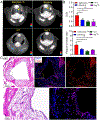Development of a CCR2 targeted 18F-labeled radiotracer for atherosclerosis imaging with PET
- PMID: 38422918
- PMCID: PMC10964492
- DOI: 10.1016/j.nucmedbio.2024.108893
Development of a CCR2 targeted 18F-labeled radiotracer for atherosclerosis imaging with PET
Abstract
Atherosclerosis is a chronic inflammatory disease and the leading cause of morbidity and mortality worldwide. CC motif chemokine ligand 2 and its corresponding cognate receptor 2 (CCL2/CCR2) signaling has been implicated in regulating monocyte recruitment and macrophage polarization during inflammatory responses that plays a pivotal role in atherosclerosis initiation and progression. In this study, we report the design and synthesis of a novel 18F radiolabeled small molecule radiotracer for CCR2-targeted positron emission tomography (PET) imaging in atherosclerosis. The binding affinity of this radiotracer to CCR2 was evaluated via in vitro binding assay using CCR2+ membrane and cells. Ex vivo biodistribution was carried out in wild type mice to assess radiotracer pharmacokinetics. CCR2 targeted PET imaging of plaques was performed in two murine atherosclerotic models. The sensitive detection of atherosclerotic lesions highlighted the potential of this radiotracer for CCR2 targeted PET and warranted further optimization.
Keywords: (18)F radiolabeling; Atherosclerosis; CCR2; Macrophages; PET/CT.
Copyright © 2024 Elsevier Inc. All rights reserved.
Conflict of interest statement
Declaration of competing interest The authors declare that they have no known competing financial interests or personal relationships that could have appeared to influence the work reported in this paper.
Figures







Similar articles
-
Visualizing Immune Checkpoint Inhibitors Derived Inflammation in Atherosclerosis.Circ Res. 2024 Oct 25;135(10):990-1003. doi: 10.1161/CIRCRESAHA.124.324260. Epub 2024 Sep 27. Circ Res. 2024. PMID: 39328090
-
Development of a CD163-Targeted PET Radiotracer That Images Resident Macrophages in Atherosclerosis.J Nucl Med. 2024 May 1;65(5):775-780. doi: 10.2967/jnumed.123.266910. J Nucl Med. 2024. PMID: 38548349 Free PMC article.
-
Synthesis and preclinical evaluation of a novel fluorine-18 labeled small-molecule PET radiotracer for imaging of CXCR3 receptor in mouse models of atherosclerosis.Res Sq [Preprint]. 2023 Feb 23:rs.3.rs-2539952. doi: 10.21203/rs.3.rs-2539952/v1. Res Sq. 2023. Update in: EJNMMI Res. 2023 Jul 13;13(1):67. doi: 10.1186/s13550-023-01017-x. PMID: 36865232 Free PMC article. Updated. Preprint.
-
PET imaging of chemokine receptors in vascular injury-accelerated atherosclerosis.J Nucl Med. 2013 Jul;54(7):1135-41. doi: 10.2967/jnumed.112.114777. Epub 2013 May 8. J Nucl Med. 2013. PMID: 23658218 Free PMC article.
-
Targeting the CCL2-CCR2 axis for atheroprotection.Eur Heart J. 2022 May 14;43(19):1799-1808. doi: 10.1093/eurheartj/ehac094. Eur Heart J. 2022. PMID: 35567558 Review.
Cited by
-
Positron emission tomography an imaging biomarker in pulmonary fibrosis: from therapeutic mechanism to treatment monitoring.EBioMedicine. 2025 Jan;111:105519. doi: 10.1016/j.ebiom.2024.105519. Epub 2024 Dec 18. EBioMedicine. 2025. PMID: 39700895 Free PMC article. No abstract available.
-
Radiolabeling and Preliminary In Vivo Evaluation of the Candidate CCR2 Targeting PET Radioligand [11C]AZD2423.Pharmaceuticals (Basel). 2025 Jan 21;18(2):135. doi: 10.3390/ph18020135. Pharmaceuticals (Basel). 2025. PMID: 40005950 Free PMC article.
-
Current status and future prospects of molecular imaging in targeting the tumor immune microenvironment.Front Immunol. 2025 Jan 22;16:1518555. doi: 10.3389/fimmu.2025.1518555. eCollection 2025. Front Immunol. 2025. PMID: 39911388 Free PMC article. Review.
-
Positron Emission Tomography Imaging of the Adaptive Immune System in Cardiovascular Diseases.Chem Biomed Imaging. 2025 Mar 19;3(4):209-224. doi: 10.1021/cbmi.4c00117. eCollection 2025 Apr 28. Chem Biomed Imaging. 2025. PMID: 40313531 Free PMC article. Review.
References
-
- Pahwa R, Jialal I, Atherosclerosis. In Statpearls, Treasure Island (FL) ineligible companies. Disclosure: Ishwarlal Jialal declares no relevant financial relationships with ineligible companies., 2023.
-
- Li W, Luehmann HP, Hsiao HM, Tanaka S, Higashikubo R, Gauthier JM, et al. Visualization of monocytic cells in regressing atherosclerotic plaques by intravital 2-photon and positron emission tomography-based imaging-brief report. Arterioscler Thromb Vasc Biol 2018;38:1030–1036. https://10.1161/ATVBAHA.117.310517 - DOI - PMC - PubMed
Publication types
MeSH terms
Substances
Grants and funding
LinkOut - more resources
Full Text Sources
Medical

